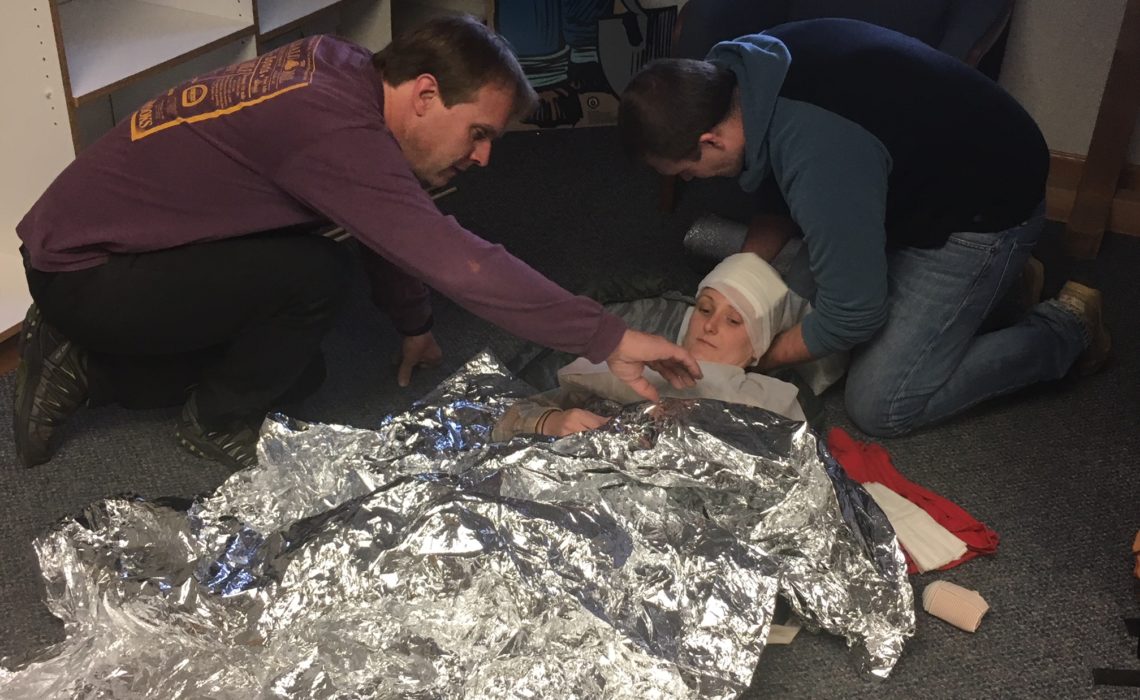
The woman lay wrapped up in tin foil, like a hot dog crinkled up in a wrapper. Only the slightest green tinge of her sleeping bag appeared at the top of the mylar blanket enveloping her. Her head poked out the top, as rope criss-crossed down her body.
“Do you feel warm?” yelled someone standing next to her.
“Too warm! I need to get out of here…” she muttered.
The “hypothermic wrap” was just one of the skills I learned this weekend during a 2-day class on Wilderness First Aid (WFA). As a Trail Patrol Volunteer with the U.S. Forest Service, I took the class to be better prepared should catastrophe arise out in the wilderness.
While I have taken many CPR and First Aid classes during the last 25 years, this class had a different focus. How to provide care to someone knowing you could be days away from the nearest road or trail head.
Some skills we practiced, I’d heard of before — how to put splint on a broken arm. How to be make a sling for a dislocated shoulder. But some were unique to a wilderness setting, such as making a traction device out of trekking poles to align a broken femur. The two ski poles are taped together to extend about six feet. Then strips of fabric, and a rope are used to create a contraption that stretches the leg vertically.
Wilderness First Aid forces you to think outside the box. While I always carry a First Aid kit with me on backpack trips, I skimp. Every ounce counts, and I don’t want to add on weight by hauling along a tourniquet, or myriad sizes of bandages. So instead, we learn how we can use a strap from our pack and a tent stake for the same purpose of stopping bleeding. I can rip my t-shirt into a long skinny strip of fabric to use as a bandage. Trekking poles, tent poles, bungee cords can all be used towards providing care in the backcountry.
The other special challenge of WFA is realizing that Emergency Medical Services (EMS) will not be arriving in ten minutes. The reality is that you probably won’t even have cell phone reception. And even if you could call, it will probably take hours, or even an overnight for someone to reach you. You must do the best to care for someone knowing the wait could be very long.
After each scenario, we discuss our evacuation plans. Could we make the patient mobile enough to walk out? Should we send one of our group to hike out and get help? If we have a Spot Satellite Tracker, should we activate the SOS signal? (The SOS signal activated the nearest law enforcement of an emergency situation, providing GPS coordinates to our exact location). If we have to leave the injured person, how best to provide for care and possible shock while we are gone?
There are a number of organizations that provide Wilderness First Aid training including REI, National Outdoor Leadership School (NOLS) and Colorado First Aid. The training is over two full days and provides a myriad of information.
At times it felt daunting to consider just how many things there are to consider. But it also left me feeling more confident about my ability to help someone should I encounter a traumatic situation. That even if the worst calamity occurs, I could help someone survive in the wilderness.

